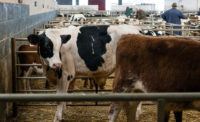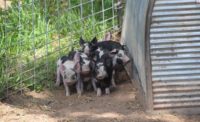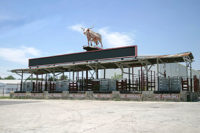Summary
In the 62 letters posted in 2014, four species are represented: cattle, swine, sheep and goats. The vast majority of enforcement actions (91.8 percent) were cattle- and swine-related, while sheep and goats made up the remaining 10 percent (8.2 percent and 1.6 percent, respectively).
When a humane-handling issue occurs, USDA-FSIS takes one of two primary enforcement actions. The first action is suspension, which halts inspection services until the humane-handling concern is appropriately addressed. Inspection resumes once a response is drafted and approved by the district office.
The second enforcement action is a notice of intended enforcement (NOIE). An NOIE is a warning statement issued when a problem arises that requires attention but does not warrant suspension of inspection. However, if the issue is not attended to, a NOIE can become a suspension.
FSIS Directive 6900.2 Revision 2 explains the grounds for issuing a NOIE rather than a suspension: NOIEs are typically used for slaughter establishments in which humane-handling infractions are rare due to a strong history of a robust systematic approach to animal welfare.
As of Nov. 13, 80.6 percent of enforcement actions were suspensions and 19.4 percent were NOIEs.
In accordance with the Humane Slaughter Act of 1978 (7 U.S.C. §§ 1901) and the regulations that enforce it (9 CFR 313), there are core sets of rules that must be followed by slaughter establishments. The regulations in 9 CFR 313 can be divided into three primary categories: (1) Stunning, (2) Handling and (3) Facilities. When the 62 enforcement actions were sorted based on these categories, stunning issues were identified as the most common at 83.3 percent. Handling concerns account for the remaining 16.7 percent. No suspensions or NOIEs were categorized as facility-related at the time of press.
Handling
Of 10 handling violations, five were concerned with unloading animals from trailers to slaughter establishments. Although many establishments choose to have plant personnel unload animals, others let drivers unload animals, sometimes unsupervised or unassisted by plant personnel. If the drivers are not well-trained, this scenario can be risky since each facility is responsible for animal welfare and handling at the point of animal arrival on facility grounds. This means the animals become the responsibility of the slaughter establishment as soon as the load of animals is waiting in queue for unloading.
Most incidents in 2014 of improper handling included unnecessary excitement of animals and excessive prod use on downer animals, but improper handling also includes electric prod use on the face and genital regions of animals; striking, kicking or hitting animals; and use of inappropriate tools, such as shovels or posts. All of these practices are considered abusive and must be prohibited.
Any person unloading animals must be trained and supervised in proper animal-handling techniques.
Regarding downer animals specifically, proper protocols must be written and enacted to allow for safe and efficient handling and the prevention of suffering. Downer cattle that arrive at the plant must be euthanized humanely and removed from the path of ambulatory animals before a trailer is unloaded.
In 2014, five incidents were related to improper treatment of downer animals, including excessive electric prod use, dragging of animals, and animals allowed to run over downed animals. Similar incidents are avoidable through training and monitoring employees as they work with downer animals.
Stunning
The most common stunning violations included multiple ineffective mechanical stuns with either a captive bolt, firearm of a combination thereof. Captive bolt stunning that did not result in instant insensibility accounted for 42.9 percent of enforcement actions, while inaccurately aimed firearms (35.7 percent) and a combination of captive bolt and firearm stunning (21.4 percent) accounted for the remaining enforcement actions.
Mechanical stunning methods are highly effective as long as equipment is well-maintained and operated according to instructions. Proper placement and animal restraint are imperative to successful stunning, which requires comprehensive employee training and monitoring by management personnel.
In 2014, there were seven incidents in which conscious animals were allowed to bleed out while signs of consciousness were observed. The prevention of return to consciousness comes through two primary means: (1) effective stunning and (2) rapid and effective sticking. A conscious animal on the bleed rail will experience excessive suffering and stress. It is expressly prohibited in 9 CFR 313 — the humane slaughter regulations — for any animal to be “shackled, cast, cut or thrown” without being rendered unconscious and insensible to pain first.
Take a systematic approach
Directive 6900.2 Revision 2 was issued by FSIS in 2011. This revision was intended to define humane-handling and stunning procedures and expectations at federally inspected slaughter facilities. Additionally, the revision described the criteria required for a “robust” systematic approach to animal welfare. It is recommended that every slaughter establishment develop such a set of criteria. A systematic approach can be thought of as a HACCP plan for compliance with the Humane Slaughter Act and 9 CFR 313.
In order for a systematic approach to be classified as “robust”, the following criteria must be met:
1. Conduct an initial assessment of where, and under what circumstances, livestock may experience excitement, discomfort or accidental injury while being handled in connection with slaughter, and of where, and under what circumstances, stunning problems may occur;
2. Design facilities and implement practices that will minimize excitement, discomfort and accidental injury to livestock;
3. Evaluate periodically the handling methods the establishment employs to ensure those methods minimize excitement, discomfort or accidental injury and evaluate those stunning methods periodically to ensure all livestock are rendered insensible to pain by a single blow; and
4. Respond to the evaluations, as appropriate, by addressing problems immediately and by improving those practices and modifying facilities when necessary to minimize excitement, discomfort and accidental injury to livestock.
A benefit to development and implementation of a “robust” systemic approach is when an issue arises that could have resulted in a suspension, it may instead result in a NOIE as long as the issue is historically an anomaly and the facility responds with appropriate corrective action, as described in their systematic approach.
As 2015 approaches, let’s continue to focus on the proper maintenance of stunning equipment, effective and meaningful employee training, and the development of a “robust” systematic approach to animal welfare if your facility hasn’t built one yet. Remember: The best way to solve most problems is to prevent them in the first place.
Dana Wagner is a graduate research assistant from the University of Wisconsin-Madison and the Animal Welfare Lab at UW-River Falls. Amanda Munger is an undergraduate research assistant at the Animal Welfare Lab at UW-River Falls. Kurt Vogel, Ph.D., is the Kraft / Oscar Mayer Faculty Scholar of Livestock Behavior and Welfare and an Assistant Professor in the Animal and Food Science Department at UW-River Falls. If you have any questions or comments, contact Vogel at kurt.vogel@uwrf.edu or (715) 425-3704.





Report Abusive Comment